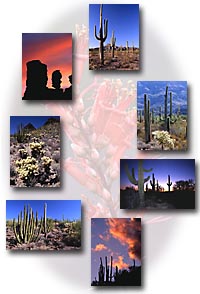
 Photography
in Sonoran Desert
Photography
in Sonoran Desert
The Sonoran Desert and American southwest are the premier destination for nature photographers. The unique desert plants make both macro and landscape photography a memorable experience. The ruggedness of the terrain, with barren mountain ranges and deep canyons, provides for a challenging hiking and photography experience. At the same time, with ample rainfall in late winter and early spring, wildflowers carpet the hills in spectacular display of colours.
The distinctive textures, shapes and colour of cacti such as saguaro, teddybear cholla, fishook, barrel, and prickly pear make a compelling subject year round. Bobcat, javalina, desert bighorn sheep, desert tortoise, Gila monster and the kangaroo rat can be seen, as well as many species and reptiles characteristic of drier climates. A good place to see the endangered Sonoran pronghorn and other wildlife is Cabeza Prieta National Wildlife Refuge west of Ajo (four-wheel-drive vehicles are recommended).
Over 300 species of birds have been recorded on the Buenos Aires NWR west of Nogales. Even better birding spots are located southeast of Tucson, in the vicinity of Sierra Vista (resource -> www.sabo.org). Try spotting all 380 species of birds reported at the San Pedro Riparian Preserve, the first area in the United States designated a Globally Important Bird Area because of the riparian habitat and its location along a major migration flyway. My favourite hiking and photography spots are the Saguaro National Park with the Arizona-Sonora Desert Museum nearby, and the Organ Pipe Cactus National Monument.
You will need lenses to cover ultra-wide to telephoto angles. Macro, or any lens that would allow closeup photography will be needed to record intricate details of cacti texture, and for desert flowers such as this ocotillo (Fouquieria splendens) in bloom. Be prepared to photograph landscapes, wildlife and plant closeups in equal proportions. Also bring a pair of tweezers for extracting cactus needles from skin and clothing, and a small pair of pliers for pulling spines and thorns from your boots. Carry a small first aid kit and always have an ample supply of drinking water when wandering through the wilderness.
When photographing short cacti with wide-angle lens, try positioning your camera to capture the plants in prominent foreground and at the same time, the environment they grow in. Experiment photographing cacti in backlight, to get a beautiful shiny halo effect produced by light reflecting from the tiny spines. Images can be made even more effective if you are lucky enough to find a dark background like a mountain slope in shadow. Take advantage of the low angle of the rising sun minutes after dawn, and keep the sun just outside of the image frame. Use of a lens shade is mandatory, to prevent extraneous light bouncing off the lens elements and producing flare effect.
The tree-shaped cactus you see it the foreground is a chain-fruit cholla (image on left). They are named this way because the flowers and fruit are located on the top of the fruit of the previous year until long chains hang from the plant. The fruit are often sterile, and are not used for reproduction. Instead, joints of the plant detach and short "branches" scatter around, taking root and growing new plants. Beware! Chain-fruit cholla is also known as the "jumping cactus" because its spiny detach easily and attach to skin or clothing. Never attempt to remove cactus segments with bare hands. Use a stick or two pieces of rock instead.
11 January, 2011
Contact us ![]() Privacy policy
Privacy policy ![]() Terms of use
Terms of use
Copyright © Branimir Gjetvaj, all rights reserved
www.branimirphoto.ca